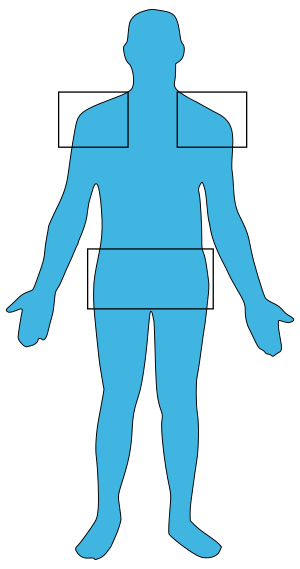Polymyalgia rheumatica
| Polymyalgia rheumatica | |
|---|---|
 |
|
| In polmyalgia rheumatica, pain is usually located in the shoulders and hips. | |
| Classification and external resources | |
| Specialty | Rheumatology |
| ICD-10 | M35.3 |
| ICD-9-CM | 725 |
| DiseasesDB | 10331 |
| MedlinePlus | 000415 |
| eMedicine | emerg/473 |
| Patient UK | Polymyalgia rheumatica |
| MeSH | D011111 |
Polymyalgia rheumatica (PMR) is a syndrome with pain or stiffness, usually in the neck, shoulders, upper arms, and hips, but which may occur all over the body. The pain can be very sudden, or can occur gradually over a period. Most people with PMR wake up in the morning with pain in their muscles; however, cases have occurred in which the person has developed the pain during the evenings or has pain and stiffness all day long. People who have polymyalgia rheumatica may also have temporal arteritis, an inflammation of blood vessels in the face which can cause blindness if not treated quickly. The pain and stiffness can result in a lowered quality of life, and can lead to depression.
Polymyalgia rheumatica is often seen in association with temporal arteritis. It is thought to be brought on by a viral or bacterial illness or trauma of some kind, but genetics does play a factor as well. Persons of Northern European ancestry are much more prone to this illness. There is no true and certain laboratory test, but C-reactive protein (CRP) and erythrocyte sedimentation rate (ESR) can be indicators of inflammation.
PMR is usually treated with courses of oral corticosteroids. Most people need to continue the corticosteroid treatment for two to three years. PMR sometimes goes away on its own in a year or two, but medications and self-care measures can improve the rate of recovery.
PMR was first established as a distinct disease in 1966 by a case report on 11 patients at Mount Sinai Hospital in New York, NY. It takes its name from the Greek word Πολυμυαλγία "polymyalgia" which means "pain in many muscles".
A wide range of symptoms can indicate if a person has polymyalgia rheumatica. The classic symptoms include:
About 15% of people who are diagnosed with polymyalgia rheumatica also have temporal arteritis, and about 50% of people with temporal arteritis have polymyalgia rheumatica. Some symptoms of temporal arteritis include headaches, scalp tenderness, jaw or facial soreness, distorted vision, or aching in the limbs caused by decreased blood flow, and fatigue.
...
Wikipedia
